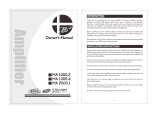6
BassLink provides several controls and indicators
that simplify sonic integration with virtually any
vehicle’s unique acoustic properties. They are
located on the front and side panels, as shown in
Figures 11 and 12.
Figure 11. BassLink controls on the front panel.
POWER LED:This indicator will glow red when
BassLink is operational.
GAIN Control: Use this control to adjust the rela-
tive volume (loudness) of BassLink with respect
to the other speakers in the vehicle.
CROSSOVER: Use this control to adjust the
amount of high-frequency information present in
BassLink’s output. A lower value signifies less
high frequencies will be amplified.
BASS BOOST: Use this control to correct any
perceived peak or dip in the bass response
(typically around 40Hz in most vehicles). Set the
control to any value between –6dB and +3dB,
according to what sounds best.
Figure 12. BassLink controls on right side panel.
PHASE Control: Use this switch to reverse the
phase of BassLink’s output with respect to its
input. Choose the position (0° or 180°) that
sounds the best.
Note: Depending on BassLink’s orientation and
location in a vehicle, reversing the phase may
may (or may not) increase or decrease the
amount of upper bass being reproduced.
AUTO TURN-ON: For speaker-level connections,
use this switch to activate (or deactivate) BassLink’s
automatic turn-on circuit. For most speaker-level
applications, slide the switch to AUTO. However, if
your system produces false turn-on signals or uses
a remote (REM) connection, slide the switch to OFF.
REMOTE GAIN CONTROL: Use this RJ-11 jack to
connect the optional remote SUB LEVEL control.
SERVO LED:This indicator glows green when the
subwoofer is at maximum excursion and the
amplifier is modifying the output to maintain
maximum performance. Be sure to monitor this
indicator during BassLink setup (see Tuning
BassLink). When properly tuned, the SERVO LED
should light momentarily during high-level bass
transients. Avoid adjustments that cause the LED
to remain lit for extended periods.
CONTROLS AND FUNCTIONS
1. Make sure the head unit is off and its volume
control is set to minimum.
2. On BassLink’s front panel, initially set all con-
trols to their midpoint positions, as shown in
Figure 11. On BassLink’s side panel, initially set
PHASE to 0° and AUTO TURN-ON to AUTO, as
shown in FIgure 12.
3. Turn on the head unit and play a favorite music
track that has substantial bass. Set the volume
control to 75 percent of the total output
(approximately 3 o’clock on rotary controls).
4. Adjust the GAIN control clockwise until the
SERVO LED (on BassLink’s side panel) begins
to flash with each bass note but doesn’t stay
lit continuously.
5. Listen to your system, making a mental note
of the amount of upper bass being reproduced.
6. Switch the PHASE control to 180° and listen
again for upper bass content. There may be
more upper bass, less upper bass, or no
change at all. The position that provides the
most upper bass is correct, but choose either
setting according to your taste.
7. Adjust the CROSSOVER control clockwise or
counterclockwise until you hear only low-fre-
quency information. For example, you should
NOT hear any vocals coming from BassLink
when seated in the normal listening position.
8. Adjust the BASS-BOOST control clockwise or
counterclockwise to suit your taste.
9. Recheck the SERVO LED to make sure it’s
flashing in time with the bass but is not lit
continuously. If it is lit continuously, adjust the
GAIN control counterclockwise until the
SERVO LED only flashes.
Note: In most cases, the above steps will provide
satisfactory tuning. However, the actual process
may require several readjustments of each control,
since the settings will interact with each other.
If necessary, consult your authorized Infinity
car audio dealer for help in tuning your system.
TUNING BASSLINK








